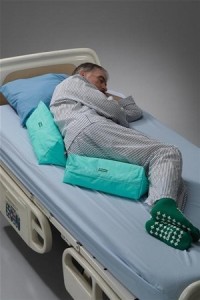- Providing Helpful Healthcare Products Since 1999 | Our Hours: 8 AM - 5 PM CST Mon - Fri
- +1-877-750-0376
Bed Positioning And Limited Mobility Round 2
Bed Positioning And Limited Mobility
July 9, 2015Moon Day: “Zero Gravity” Wedge Cushion
July 20, 2015
We talked in a previous post about the effects of gravity on someone with a low range of motion. Those of us who cannot move in bed much or reposition ourselves know the importance of attention to detail. Being positioned in a haphazard manner without proper planning can lead to pain and even visible sores the longer we lie in bed.
In that last post, we looked at tips for handling draw sheets and pillows in between the leg and under the arm. Let’s look at some more tips when considering the physics of gravity for patients who cannot move on their own.
Make sure back alignment pillows are tucked
Putting one or more pillows along the patient’s back helps to keep them on their side when they wish to be in that position. For a patient who cannot move, if you do not secure their side position with back support, they will often fall partially back onto their back because of the natural force of gravity.
However, even with a pillow, if it is not tucked at least a little bit under the back, it does not really work well as a back support. It is just lying there next to the patient without really doing anything for them. You may have to hold the patient on their side or even lift their back a bit to get the pillow under them enough to actually provide support.
To make this whole part easier, a lot off people use back wedge pillows, which are shaped to facilitate this tucking process. For instance, we offer Posey Lateral Positioning Wedges for exactly this purpose.
Remember the feet
When a patient is lying on their back, caregivers will often place a pillow under the patient’s knees. It is good for the knees to be slightly angled, because this is a more natural position for sleeping plus it helps blood circulation in the leg for people who have been sitting in a wheelchair. It also prevents pain for patients with knee contractures. (See our Knee Rest Wedge Pillow.)
However, one common problem in this situation is that the patient’s heels rest even harder against the bed, resulting in pressure pain or even pressure sores. Prevent it either by positioning the pillow so that their lower leg gets more support or by placing another pillow under the lower legs.
We hope these posts will help you when taking care of a patient or loved one who cannot move very well on their own. Let us know how these strategies work for you!


